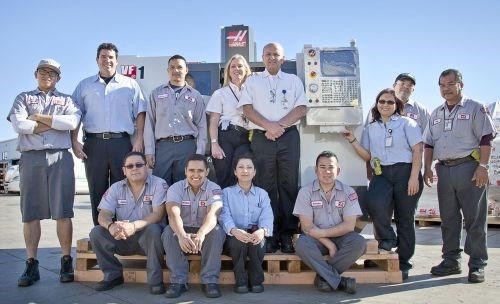The team involved in producing Haas Automation’s 125,000th machine tool poses in front the historic machine outside the factory in Oxnard, California.
I remember the buzz surrounding the introduction of the VF-1 by Haas Automation in 1988. At the time, many industry observers were writing off the ability of any U.S.-based machine tool builder to build low-cost, commodity CNC machining centers and make a profit. But here was this spunky company out in California producing a CNC machine that was priced below $50,000. At the time, this segment of the market seemed forever lost to imports from the other side of the Pacific Ocean. That Haas, and a few other newcomers to machine tool building, were game enough to fight back was rather exciting. At first, we weren’t sure if they could succeed. Some didn’t. Haas Automation, however, certainly has.
The announcement that the company has produced its 125,000th machine tool is proof. This machine, a 2012 version of the VF-1, came off the production line at Haas Automation’s sprawling factory in Oxnard on January 26. According to the official announcement, this machine proves something more—that Haas has come a long way in offering additional value to its customers over the years, as revealed by a simple comparison of the first VF-1 to its latest version.
When Haas introduced the VF-1 in 1988 at IMTS in Chicago, the suggested retail price was $49,900. Adjusting for inflation, that’s equivalent to about $94,880 in 2011 dollars. The machine featured 20- by 16- by 20-inch travels, a 7.5-hp (peak) spindle motor, speeds as high as 5,000 rpm, brush-style servomotors on all axes, 480 ipm rapids, a 16-tool ATC, and the Haas CNC control, which featured a “whopping” 128 K of program memory, and a maximum processing speed of 20 blocks per second. Additional options were essentially non-existent.
The company says that today’s VF-1 is easily 10 times the machine as its 1988 namesake, yet its base price is $45,995, or about $24,190 in 1988 dollars. The VF-1 still has travels of 20 by 16 by 20 inches, but now features a 30-hp (peak) spindle with a high-performance vector drive, speeds as high as 8,100 rpm standard, brushless servos on all axes, 1,000-ipm rapids, a 20-tool ATC, and the Haas control, which now features 1 MB of program memory (eight times the 1988 figure) and provides processing speeds as high as 1,000 blocks per second (or 50 times faster than in 1988). And those are the facts about the base-model machine. The company notes that “a wide selection of high-productivity options is available to boost performance–and value–even further.”
Today, Haas Automation manufactures CNC vertical machining centers, horizontal machining centers, CNC lathes and rotary products. The company also builds a variety of specialty machines, including five-axis machining centers, mold making machining centers, toolroom machines and gantry routers.
What else was happening in the world of metalworking back in 1988? Click here for a peek at some interesting stuff form the archives of MMS.
Related Content
-
To meet an increase in demand, this shop invested heavily in automation solutions and five-axis machines to ramp up its production capabilities.
-
Taking advantage of a feature that’s already on the machine tool, Lang’s Haubex system uses the toolchanger to move and store parts, making it an easy-to-use and cost-effective automation solution.
-
Doubling sales requires more than just robots. Pro Products’ staff works in tandem with robots, performing inspection and other value-added activities.




















.jpg;maxWidth=300;quality=90)






